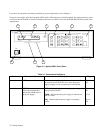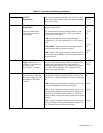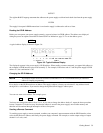
Getting Started38
7. Set the current to 0.5 A by pressing:
ISET
.
5 ENTER
8. Check that the display reads approximately 0 V and 0.5 A.
9. Enable the overcurrent protection circuit by pressing:
OCP
10. Check that the OCP ENBLD annunciator is on indicating that overcurrent protection is enabled and the display reads
"OVERCURRENT". When in overcurrent, the output is disabled.
11. Disable the overcurrent protection circuit by pressing:
OCP
12. Reset the output by pressing:
OC
RST
13. Check that the display reads approximately 0 V and 0.5 A.
14. Turn off the supply and remove the jumper from the output terminals.
Repeat the tests given on pages 37 & 38 for the other output channel (s) using the key.
Introduction To Remote Operation
The following paragraphs explain the fundamentals of operating the supply remotely from a computer. Only a few
commonly used programming commands will be discussed. Refer to Chapter 5 for a detailed description of all the
commands. The intent of this discussion is to help first time users to quickly become familiar with operating their supply
from a computer.
The programming examples that follow assume that a computer is connected to the GP-IB connector on the rear of your
supply (see Chapter 2), power is applied, and loads are not connected to any of the supply’s outputs. The examples used are
primarily for Agilent Series 200 computers using Agilent BASIC language. Read the manuals for your particular computer
to find out which statements you must use.
Enter/Output Statements
The programming statements you use to operate your supply from remote depend on your computer and its language. In
particular, you need to know the statements your computer uses to output and enter information. For example, the Agilent
BASIC language statement that addresses the power supply to listen and sends the command to the power supply is:


















